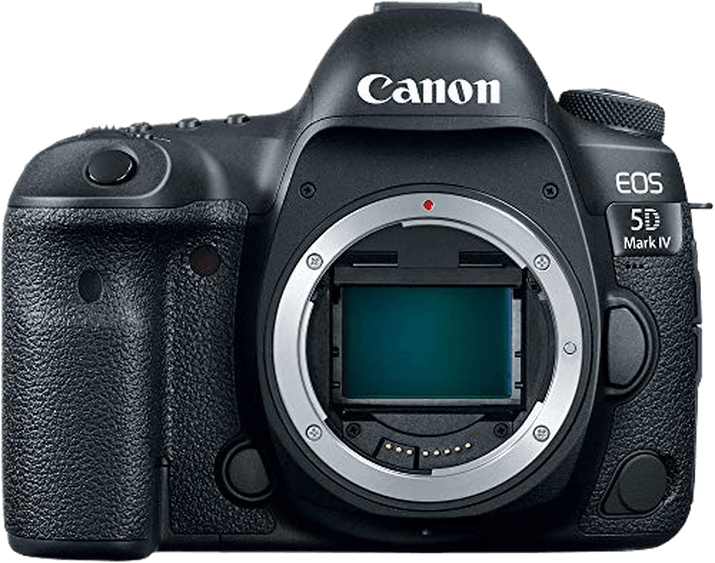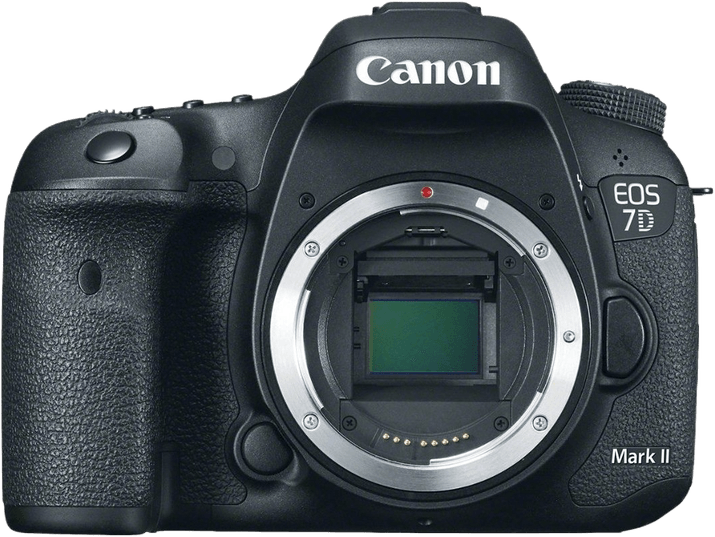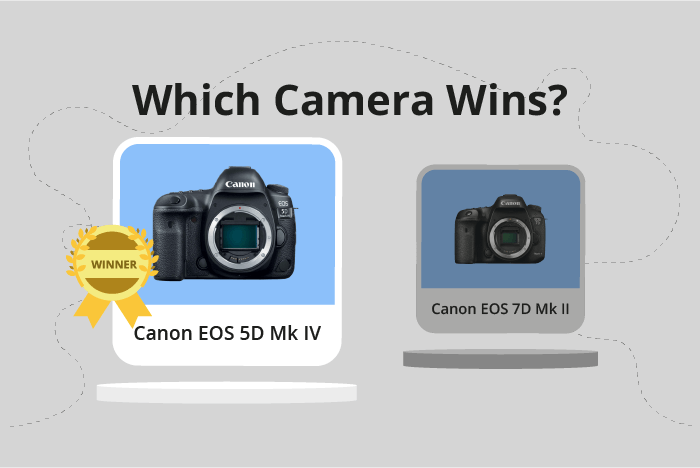Canon EOS 5D Mark IV vs EOS 7D Mark II Comparison
Canon EOS 5D Mark IV

Canon EOS 7D Mark II

The Canon EOS 5D Mark IV outshines the Canon EOS 7D Mark II with a score of 75/100 compared to 60/100. Both cameras are DSLRs and share similar dimensions, with the 5D Mark IV measuring 151 x 116 x 76mm and the 7D Mark II at 149 x 112 x 78mm. They also have comparable weights, with the 5D Mark IV weighing 890g and the 7D Mark II at 910g.
The 5D Mark IV, released in 2016, boasts a higher launch price of $3500, reflecting its superior performance. In contrast, the 7D Mark II, released in 2014, is more affordable with a launch price of $1800. This lower price may appeal to budget-conscious photographers, despite the lower score.
Taking these factors into account, the Canon EOS 5D Mark IV is the better camera due to its higher score, while the Canon EOS 7D Mark II offers a more budget-friendly option without drastically compromising on size and weight.
Canon EOS 5D Mark IV vs EOS 7D Mark II Overview and Optics
The Canon EOS 5D Mark IV outperforms the Canon EOS 7D Mark II in optics, scoring 76/100 compared to the latter’s 61/100. Both cameras share several specifications, including a CMOS sensor, no image stabilization, and compatibility with Canon EF lenses. However, the 5D Mark IV boasts superior features in certain areas, while the 7D Mark II excels in others.
The 5D Mark IV possesses a higher megapixel count at 30.4, compared to the 7D Mark II’s 20.2. This results in better image resolution and detail. Additionally, the 5D Mark IV has a full-frame sensor, while the 7D Mark II has an APS-C sensor. The full-frame sensor produces higher image quality and performs better in low light conditions. Furthermore, the 5D Mark IV’s Digic 6+ processor and a DXOMARK sensor score of 91 ensure faster processing and better overall image quality.
On the other hand, the 7D Mark II has a faster shooting speed of 10 frames per second, compared to the 5D Mark IV’s 7 frames per second. This feature makes the 7D Mark II more suitable for action and sports photography. The 7D Mark II also utilizes a dual Digic 6 processor, which allows for faster continuous shooting, despite having a lower DXOMARK sensor score of 70.
In terms of optics, the Canon EOS 5D Mark IV surpasses the Canon EOS 7D Mark II due to its higher megapixel count, full-frame sensor, and superior processor. However, the 7D Mark II’s faster shooting speed may be preferable for specific photography styles. Ultimately, the choice between these two cameras depends on individual preferences and intended use.
Canon EOS 5D Mark IV vs EOS 7D Mark II Video Performance
The Canon EOS 5D Mark IV outperforms the Canon EOS 7D Mark II in video capabilities with a score of 91/100 compared to 56/100. Both cameras have similarities in their video specifications, but the 5D Mark IV has significant advantages over the 7D Mark II, while the latter has limited areas where it is superior.
Both cameras share some common features in video specifications. They have autofocus, manual focus, and the ability to capture audio. However, the 5D Mark IV is superior in several aspects. With a maximum video resolution of 4K (4096 x 2160), it offers higher quality videos than the 7D Mark II, which has a maximum video resolution of Full HD (1920 x 1080). Additionally, the 5D Mark IV has a higher maximum video frame rate of 120fps, compared to the 7D Mark II’s 60fps. This difference allows for smoother slow-motion footage. Moreover, the 5D Mark IV has a built-in time-lapse functionality, which the 7D Mark II lacks.
The 7D Mark II has fewer advantages over the 5D Mark IV. One possible benefit is its lower price, making it a more budget-friendly option for those who do not require the advanced video capabilities of the 5D Mark IV.
When comparing the video capabilities of the Canon EOS 5D Mark IV and the Canon EOS 7D Mark II, it is evident that the former is the superior choice. With higher video resolution, frame rate, and built-in time-lapse functionality, the 5D Mark IV offers a more comprehensive package for videographers. The 7D Mark II may be suitable for those on a budget, but its limited video features make it a less appealing choice for those seeking advanced video capabilities.
Canon EOS 5D Mark IV vs EOS 7D Mark II Features and Benefits
The Canon EOS 5D Mark IV outperforms the Canon EOS 7D Mark II in features with a score of 74 to 57. Both cameras share some key specifications, including GPS, WiFi, and the lack of Bluetooth. However, the 5D Mark IV has distinct advantages that contribute to its higher score.
The 5D Mark IV’s screen is larger at 3.2 inches compared to the 7D Mark II’s 3-inch screen. Additionally, the 5D Mark IV’s screen resolution is significantly higher at 1,620,000 dots, while the 7D Mark II has a resolution of 1,040,000 dots. This difference results in a clearer and more detailed display on the 5D Mark IV.
Another notable advantage of the 5D Mark IV is its touchscreen functionality, which the 7D Mark II lacks. This feature allows for easier and more intuitive navigation and control of the camera settings.
Despite its lower feature score, the 7D Mark II still offers excellent performance in certain areas. Both cameras have GPS and WiFi capabilities, enabling users to geotag images and transfer files wirelessly. They also both lack flip screens and Bluetooth, indicating that neither camera has a clear advantage in these aspects.
Taking all of these factors into account, the Canon EOS 5D Mark IV’s superior screen size, resolution, and touchscreen functionality make it the better option in terms of features. However, the Canon EOS 7D Mark II remains a strong contender, offering comparable performance in GPS, WiFi, and other shared specifications.
Canon EOS 5D Mark IV vs EOS 7D Mark II Storage and Battery
The Canon EOS 5D Mark IV wins the storage and battery comparison with a score of 71/100, while the Canon EOS 7D Mark II scores 65/100. Both cameras have two memory card slots and accept SD/SDHC/SDXC and Compact Flash cards. They also use the same battery type, LP-E6N, and neither offers USB charging.
The 5D Mark IV outperforms the 7D Mark II in battery life, providing 900 shots compared to the 7D Mark II’s 670 shots. This advantage allows for more shooting time before needing to replace or recharge the battery.
On the other hand, the 7D Mark II does not offer any notable advantages in storage and battery over the 5D Mark IV. Both cameras share similar storage capabilities, and the 5D Mark IV simply offers better battery life.
Considering these factors, the Canon EOS 5D Mark IV is the superior choice in terms of storage and battery performance. Its longer battery life ensures users can capture more shots without interruption, making it a more reliable option for various shooting situations.
Canon EOS 5D Mark IV vs EOS 7D Mark II – Our Verdict
Are you still undecided about which camera is right for you? Have a look at these popular comparisons that feature the Canon EOS 5D Mark IV or the Canon EOS 7D Mark II:

